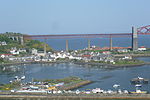Inverkeithing railway station
1877 establishments in ScotlandFormer North British Railway stationsInverkeithingPages with no open date in Infobox stationRailway stations in Fife ... and 5 more
Railway stations in Great Britain opened in 1877Railway stations served by Caledonian SleeperRailway stations served by London North Eastern RailwayRailway stations served by ScotRailUse British English from December 2017

Inverkeithing railway station serves the town of Inverkeithing in Fife, Scotland. The station is managed by ScotRail and is on the Fife Circle Line, 13+1⁄4 miles (21.3 km) north west of Edinburgh Waverley. The station is popular with commuters travelling to Edinburgh from Fife and beyond, thanks to its location beside the M90 motorway. Immediately north of the station, the Fife Circle Line splits in two - the main line continuing along the coast via Aberdour whilst the branch heads inland towards Dunfermline. South of Inverkeithing the line continues towards Edinburgh via the Forth Bridge.
Excerpt from the Wikipedia article Inverkeithing railway station (License: CC BY-SA 3.0, Authors, Images).Inverkeithing railway station
Chapel Place,
Geographical coordinates (GPS) Address Nearby Places Show on map
Geographical coordinates (GPS)
| Latitude | Longitude |
|---|---|
| N 56.0351 ° | E -3.3954 ° |
Address
Inverkeithing
Chapel Place
KY11 1NQ
Scotland, United Kingdom
Open on Google Maps









